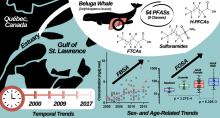| Title | Hydroxylated 2-Ethylhexyl tetrabromobenzoate isomers in house dust and their agonistic potencies with several nuclear receptors. |
| Publication Type | Journal Article |
| Year of Publication | 2017 |
| Authors | Peng, H, Sun, J, Saunders, DMV, Codling, G, Wiseman, S, Jones, PD, Giesy, JP |
| Journal | Environ Pollut |
| Volume | 227 |
| Pagination | 578-586 |
| Date Published | 2017 Aug |
| ISSN | 1873-6424 |
| Keywords | Air Pollution, Indoor, Bromobenzoates, Canada, Dust, Environmental Monitoring, Flame Retardants, Halogenated Diphenyl Ethers, Humans |
| Abstract | In the current study, by combining ultra-high resolution (UHR) MS spectra, MS spectra, and derivatization, three hydroxylated isomers of 2-ethylhexyl tetrabromobenzoate (OH-TBB) were identified in Firemaster 550 and BZ-54 technical products. Also, a new LC-UHRMS method, using atmospheric pressure chemical ionization (APCI), was developed for simultaneous analysis of OH-TBB, TBB, hydroxylated bis(2-ethylhexyl)-tetrabromophthalate (OH-TBPH) and TBPH in 23 samples of dust collected from houses in Saskatoon, SK, Canada. OH-TBBs were detected in 91% of samples, with a geometric mean concentration of 0.21 ng/g, which was slightly less than those of OH-TBPH (0.35 ng/g). TBB was detected in 100% of samples of dust with a geometric mean concentration of 992 ng/g. Significant (p < 0.001) log-linear relationships between concentrations of OH-TBBs, TBB, or OH-TBPHs and TBPH in dust support the hypothesis of a common source of these compounds. OH-TBBs were found to be strong agonists of peroxisome proliferator-activated receptor gamma (PPARγ) and weaker agonists of the estrogen receptor (ER), but no agonistic potencies was observed with the androgen receptor (AR). Occurrence of OH-TBBs in technical products and house dust, together with their relatively strong PPARγ potencies, indicated their potential risk to health of humans. |
| DOI | 10.1016/j.envpol.2017.04.094 |
| Alternate Journal | Environ. Pollut. |
| PubMed ID | 28505588 |
Environmental Chemical Biology

